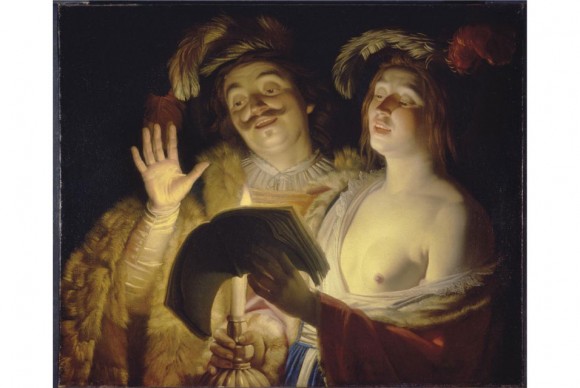17th century Dutch painting touting Hermitage Museum provenance to lead Christie’s Old Master Sale
May 5, 2013 by All Art News
Filed under Art Market, Featured
NEW YORK, NY.- Christie’s announced that the Old Master Paintings sale on June 5 in New York will be led by Gerrit van Honthorst’s The Duet, a significant work with an exceptionally distinguished Russian provenance, which includes the collection of Count Alexander Stroganov, art advisor to Catherine the Great, as well as the Hermitage Museum. Painted in 1624 at the height of Honthorst’s career, this picture is one of the finest examples of the kind of nocturnal revelry for which the Dutch artist is celebrated. On display at the Montreal Museum of Fine Arts for more than 40 years, the picture was recently restituted to the heirs of Bruno Spiro, who was forced to sell the painting during World War II. The Duet is estimated at $2-3 million.
“This is a painting which has everything: it is a beautiful composition; it is by a major artist at the peak of his career; it is in pristine condition; and coming from the collections of Count Alexander Stroganov and then the Hermitage it has a superb provenance. Added to all this is the satisfaction that Christies is bringing to the marketplace a work which has, after a period of seventy five years, been returned at last to its rightful owners,” commented Nicholas Hall, Co-Chairman, Old Masters & 19th Century Art.

Gerrit van Honthorst (Utrecht 1592-1656), The Duet, 1624 (estimate: $2-3 million). Photo: Christie’s Images Ltd 2013
Gerrit van Honthorst (Utrecht 1592-1656) was among a small yet influential group of artists active in the 17th-century Netherlands influenced by Caravaggio who were aptly known as the ‘Utrecht Caravaggisti’. The Duet is emblematic of popular paintings in Utrecht in the 1620s which depicted musical subjects of half-length musicians and singers illuminated by a concealed light source. In this seductive picture, a hearty, mustachioed man and an alluringly clad young woman stand together over an open book singing by candlelight. Their lips parted in song, the couple wears sumptuous, theatrical clothing of feathers, fur and brightly colored fabrics. Honthorst’s extraordinary mastery in rendering the effects of candlelight earned him the moniker ‘Gherardo delle Notti’, or ‘Gherardo of the Night’.
In The Duet, the amorous content of the scene is overt as the couple stands pressed together, the woman’s breast exposed. A contemporary audience would have understood the act of song to be a metaphor for flirtation and lovemaking. The eroticism of this painting also links it to the courtesan scenes which were popular in Utrecht in this period. The woman’s revealing dress and the feather in her hair suggest that she may be a courtesan, the man her client.
Honthorst’s scenes of nocturnal merrymaking were highly sought after by discerning collectors, and in the 19th century The Duet belonged to the legendary Stroganov Collection in St. Petersburg, Russia. Building on the pursuits of his father, Count Alexander Stroganov (1733-1811) amassed an extraordinary art collection for which he built a large picture gallery in the Stroganov Palace on Nevsky Prospect, one of the grandest 18th-century buildings in the city. This superb collection included masterpieces by Italian, Spanish, French and German Old Masters as well as preeminent Dutch and Flemish artists such as Rembrandt, Peter Paul Rubens and Anthony van Dyck.
Stroganov was the art advisor to Catherine the Great, as well as President of the Imperial Academy of Arts, and his gallery became a popular meeting place for artists and connoisseurs. He was also a generous patron of prominent living artists such as Jean-Baptiste Greuze, Marie-Louise Elisabeth Vigée-Lebrun and Hubert Robert. He published a catalogue of his collection, the first of its type in Russia, using French texts as his model. From the various editions of these catalogues, it can be determined that Stroganov acquired The Duet after the publication of the 1793 catalogue, in which it is not included, but before that published in 1807, where it is listed as La leçon de chant, or The Singing Lesson.
The picture passed by descent through the family and appears in the 1864 catalogue of the Hermitage and local collections. After 1912, it was housed at the Hermitage Museum along with other Stroganov pictures, two years before Count Sergei Alexandrovich (1852-1923) opened the family palace to the public in 1914. Following the Revolution of 1917, the family’s collection was nationalized, and in 1925 the Stroganov Palace was made part of the Hermitage Museum. In 1931, The Duet was sold in a special auction organized by the Soviet regime held at Lepke, Berlin.
Later that same year, it was purchased by Bruno and Ellen Spiro, from whom it was seized by National Socialists and sold in 1938 along with the contents of Villa Spiro, their residence in Berlin. It passed through several German private collections before being acquired in 1969 on the Munich art market by the Montreal Museum of Fine Arts, from which it was restituted to the heirs of the Spiro family in April 2013.
